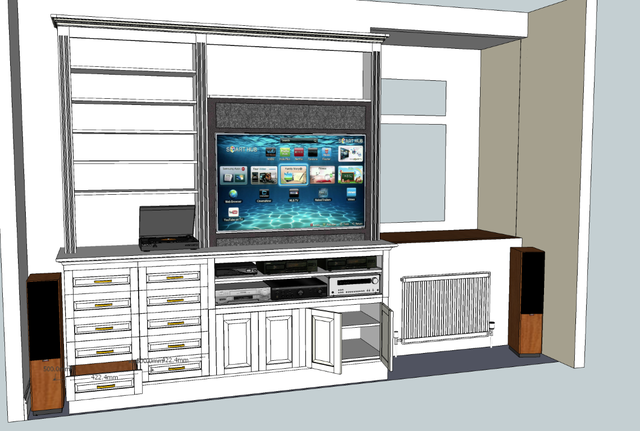Built in media centre
Introduction
Ever since doing the Classic large bookcase and cupboard I had harboured a desire to create something in the same style to be used as an integrated AV storage unit. The design goal was to provide storage for lots of CDs, a place to install various bits of AV gear and make them easy to access and use, plus space to mount a TV, while hiding speakers etc. If it could have some more shelves for books and even LPs even better.
The stumbling block was coming up with an aesthetically pleasing design that also met the requirements. After a few iterations of sketchup models, the above design was selected.
Design
The construction was designed to look like a fairly classic bit of "built in" Victorian carpentry (if one glosses over the whole anachronism of a Victorian era AV centre!) The construction technique was to be more "smoke and mirrors" however - lots of sheet goods assembled into boxes and then decorated with some slightly fancy face frames to make it look pretty.
It needed large drawers to hold CDs since the last seven drawer unit I built 20 odd years ago (the first bit of proper furniture I made) was long since full. Decent drawer runners to make them easy to use would also be good. Books shelf space also soon seems to get consumed quickly, so some more of that. Getting the AV gear out of the HiFi rack and from low down under the old TV would also be nice along with a space to hide some wiring, and bits of sound system like the 5.1 centre speakers was also on the list.
Construction
Working from the sketchup model I created a cut list in a spreadsheet. Then I used the free version of MaxCut 2 to allocate those pieces to sheet goods and work out the total requirement for sheets. The cabinets were to be made from a mixture of 2/4" ply and MDF. Drawers from 1/2" ply, and backs etc from 3/8" MDF. Normal PAR softwood for all the face frames and detailing.
Most of the main units were in one way or another a simple box. To make assembly easier and the result a little stronger, the edges of these were usually rebated on a table saw with a dado stack fitted (this makes registration at the corners far more positive). The boxes glued and either pin nailed or screwed together (with the glue doing the bulk of the work).
Drawers
The first bit to tackle was the drawer boxes since these were nearly all the same and could be batched out quickly (two were made a little shorted in drawer length to allow them to close over a socket on the wall behind them). Since these would mostly hold CDs (approx 120 per drawer), they needed to be very strong. The sides were cut from 1/2" ply, and then the corners finger jointed on the table saw with a finger joint sled and a dado blade. This is a very strong and fast construction technique, since multiple sides can be cut at once. The drawers were to have an applied on front that was both wider and taller than the box. This would hide the drawer runner. The base was cut from 5mm ply and a rebate cut on the table saw to create a groove for it to sit in. (all the sides could simply have a through rebate, since the drawer front would hide the notch).
Normally its easier to cut the fingers slighter deeper than they need be be, and they then can be trimmed flush after assembly. Since there would be 80 joints to trim flush here, a simple jig was setup on the table saw with a secondary fence clamped to the side of the main one - but above the blade. With careful adjustment This created a space where the protruding fingers could be run past the blade such that it just glanced the surface, trimming the joint flush.
